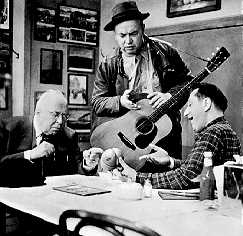But there was
more than the Chicago School to WMAQ-TV's story. It was---and is---NBC Chicago.
So WMAQ-TV fed, and was fed by, the network.
On January 13, 1949, Lanny Ross moved his NBC-TV network program, sponsored by
Swift & Co., to Chicago for one evening. This was the first major night-time
TV variety program to originate from Chicago.
| Right:
Folk singer Win Stracke was featured with star Stud's Terkel in "Stud's
Place," one of Channel 5's early programs. (Phil Lord sits at left.) |
 |
By February of that
year, Channel 5 audiences were enjoying a variety of NBC-TV network programs.
In addition to the Swift show, fed from New York, they included "Kraft Television
Theater", ventriloquist Paul Winchell, Madison Square Garden boxing, Admiral's
''Broadway Review'', ''Philco TV Playhouse", "Colgate Theater",
"Americana'', "Girl About Town", "Phil Silvers Show",
"Your Show Time", "Howdy Doody", "Meet the Press'', "Who
Said That?" and "Kukla, Fran
and Ollie", which originated from NBC Chicago.
The TV split-screen technique, now in common use, was demonstrated for the first
time in Chicago by Channel 5 on January I 2, 1949, before the Chicago Radio Management
Club.
 |
Left:
"Hawkins
Falls" was television's first daytime serial. In the course of it's run
on channel 5 and the NBC-TV network, it employed scores of Chicago actors.
|
WMAQ-TV expanded to
a seven-day, 35-hour week with the addition of Saturday programming in March of
1949. By May 15th, NBC had the nation's first television network, with 33 stations.
Today the network is made up of more than 200 stations.
When Channel 5 began regular programming in January, 1949, there were 52,000 TV
sets in the Chicago area. One year later, the number had increased to an estimated
325,000 receivers. Currently, as Channel 5 celebrated its 20th anniversary, there
are more than 2,500,000 TV homes in the Chicago market area.
| Right: The
"Wayne King Show", starring
the Waltz King, his orchestra, singers and chorus, was one of WMAQ-TV's first
programs fed to the NBC Midwest TV network. |
 |
On June 22, 1949,
Channel 5's audience was given a ringside seat to a major sports event. This was
the heavyweight championship fight between Jersey Joe Wolcott and Ezzard Charles
at Chicago's Comiskey Park, which was fed to the NBC-TV network.
Then, on September 28th, Channel 5 introduced what was to become big-screen television
theater. A boxing match between Harry (Kid) Matthews and Joe Smith was staged
in Studio B and transmitted by coaxial cable to a 15-by-20 foot screen in the
Conrad Hilton Hotel. Tom Duggan and Johnny
Erp were the ringside announcers.
 |
Left:
The first
boxing match ever to be staged in a television studio was telecast by Channel
5 in September, 1949 for big screen projection.
|
Channel 5's transmitter
log carried some interesting notations during the early months of operation. For
example, it was noted that on June 26, 1949, WMAQ-TV was off the air for 45 minutes
"because of lack of relief for the crew". Veteran engineers say the
shut-down was programmed deliberately, to give the operating crew a lunch break.
In February of 1950, Chicago's Studebaker Theater was leased and converted into
the midwest's largest TV studio. It was to be used for the Jack Carter Show, aired
nationwide Saturday nights on the full NBC-TV network.
Channel 5, on July 2, 1954, became the first Chicago TV station to go to the maximum
authorized power of 100 kilowatts, beamed from the highest transmitter in the
city . . . atop the Kemper Building, 747 feet above the street.
|